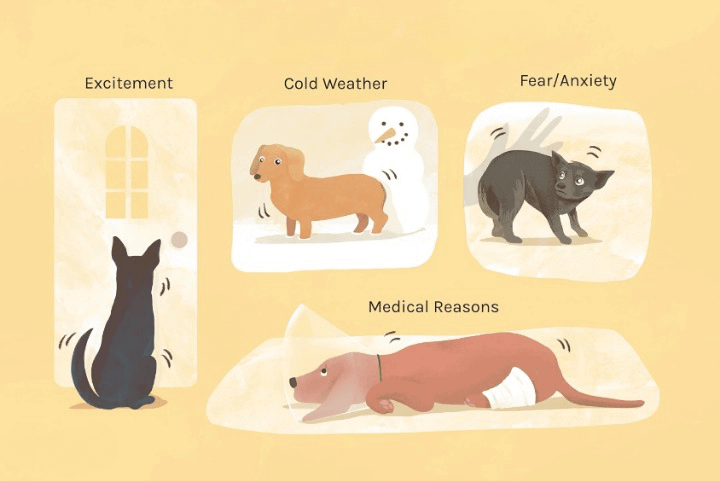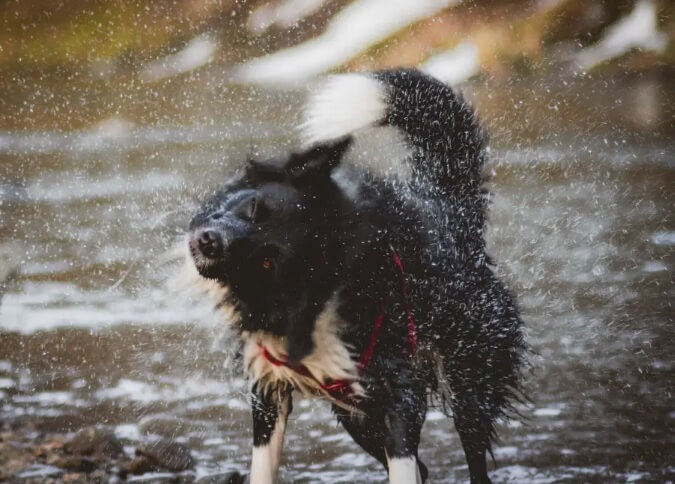Shivering in dogs is a common phenomenon that can evoke concern and empathy from pet owners. This involuntary trembling of the body, which resembles a delicate leaf quivering in the wind, captures our attention and triggers our desire to understand its underlying causes.
While shivering can be a normal physiological response to various factors, such as cold temperatures or excitement, it can also indicate potential health issues or psychological distress in dogs.
In this article, we aim to explore why dogs shiver and provide guidance on how to identify the possible reasons behind this dog behavior. By recognizing the signs and symptoms associated with different contexts, pet owners can better address their dog’s needs, whether they require veterinary care or simply comfort and support.
Understanding why our canine companions shiver allows us to serve them more effectively by ensuring their well-being and promoting their overall happiness.
Key Takeaways
- Shivering in dogs can be caused by a variety of factors including fear or anxiety, cold temperature, pain or illness, and excitement or anticipation.
- It is important to consider possible medical conditions such as hypoglycemia, stress, certain medications, and withdrawal symptoms as potential causes of shivering in dogs.
- Other factors that can contribute to dog shivering include hypothermia, nervousness or fright, kidney disease, and poisoning.
- Shivering in dogs can also be a symptom of hormonal imbalances, neurological disorders, muscle weakness or fatigue, and heart problems.
Understanding Normal Shivering in Dogs
Understanding the physiological mechanisms and evolutionary advantages of normal shivering in dogs can provide valuable insights into the adaptive nature of this behavior. Canine body temperature regulation plays a crucial role in maintaining homeostasis, and shivering is one mechanism that helps dogs maintain their body temperature within a narrow range.

When exposed to cold temperatures or experiencing fear or anxiety, dogs may engage in shivering as a behavioral response to generate heat through muscle contractions. This involuntary movement generates warmth by increasing metabolic rate and blood flow to peripheral tissues.
Additionally, shivering may also serve as a form of communication between dogs, signaling discomfort or vulnerability.
By understanding these behavioral factors in dog shivering, pet owners can better interpret their dog’s needs and provide appropriate care to ensure their well-being.
Identifying Potential Health Issues
This section will explore the two potential causes of shivering in dogs: cold or fear and pain or discomfort.
Dogs may shiver when they are exposed to cold temperatures or when they feel fearful or anxious.
Additionally, shivering can be a sign that a dog is experiencing pain or discomfort, which could be caused by an underlying health issue.
Cold or Fear as a Cause for Shivering

Cold temperatures and fear can both be contributing factors to a dog’s shivering. When dogs are exposed to low temperatures, their bodies may respond by shivering in order to generate heat and maintain their core body temperature. To address this issue, it is important for dog owners to provide adequate protection against the cold. This can include providing warm clothing or blankets, limiting outdoor exposure during extreme weather conditions, and ensuring that there are no drafts in the dog’s living environment.
Additionally, fear or anxiety can also cause dogs to shiver. In such cases, it is crucial to focus on fear management techniques such as desensitization training, creating a safe and secure environment for the dog, and seeking professional help if necessary.
By addressing these factors effectively through proper cold treatment and fear management strategies, dog owners can help alleviate their pet’s shivering and ensure their overall well-being.
Pain or Discomfort as a Possible Reason for Shaking
Pain or discomfort can manifest as shaking in dogs, highlighting the urgent need for effective pain management strategies to alleviate their suffering. Dogs may shake due to various painful conditions such as arthritis, injury, or internal organ problems.
To manage their pain effectively, the following strategies can be implemented:
- Medications: Veterinarians may prescribe pain-relieving medications to alleviate the dog’s discomfort.
- Physical therapy: Specific exercises and techniques can help reduce pain and improve mobility in dogs with musculoskeletal issues.
- Acupuncture: This alternative therapy has been found to provide pain relief by stimulating specific points on the body.
- Massage therapy: Gentle massage can help relax muscles, relieve tension, and reduce pain in dogs.
- Behavioral modifications: Creating a comfortable environment and using positive reinforcement techniques can help reduce stress and anxiety in dogs, ultimately alleviating any associated pain.
By implementing these strategies, dog owners can effectively manage their pet’s pain and enhance their overall well-being.
Addressing Anxiety and Stress
Addressing anxiety and stress in dogs can be akin to untangling a web of emotions, as their shivering may signify underlying psychological distress. Managing anxiety in dogs is important for their overall well-being. There are various techniques that can help calm an anxious dog and reduce their shivering episodes.
One effective way to manage anxiety in dogs is through behavioral modification techniques. These techniques involve gradually exposing the dog to situations or stimuli that trigger their anxiety, while providing them with positive reinforcement for calm behavior. This helps the dog learn to associate those triggers with positive experiences, reducing their anxiety over time.

Another approach is the use of calming aids or supplements. These may include pheromone diffusers, herbal remedies, or even prescription medications prescribed by a veterinarian. Calming aids can help relax an anxious dog and alleviate their shivering.
Additionally, creating a safe and comfortable environment for the dog can also contribute to managing anxiety. Providing a designated space where they feel secure, using soothing music or white noise machines, and ensuring regular exercise and mental stimulation can all help reduce stress levels in dogs.
Table:
| Technique | Description |
|---|---|
| Behavioral Modification Techniques | Gradually exposing the dog to triggers while rewarding calm behavior |
| Calming Aids | Pheromone diffusers, herbal remedies, or prescription medications prescribed by a veterinarian |
| Creating a Safe Environment | Providing a secure space, using soothing music or white noise machines, ensuring exercise and stimulation |
Seeking Veterinary Care

Seeking veterinary care is crucial in ensuring the well-being and overall health of our canine companions, as it allows for early detection and management of potential medical conditions that may be causing distress. When your dog is shivering, it is important to consult a veterinarian for proper diagnosis and advice.
Here are three reasons why seeking veterinary care is essential:
- Expertise: Veterinarians have extensive knowledge and experience in diagnosing and treating various medical conditions in dogs. They can provide accurate assessments and recommend appropriate treatment options.
- Diagnostic tests: Veterinary clinics are equipped with advanced diagnostic tools that can help identify underlying causes of your dog’s shivering, such as blood tests, X-rays, or ultrasounds. These tests can provide valuable insights into any potential health issues.
- Treatment options: Once a diagnosis is made, veterinarians can recommend suitable treatment options tailored to your dog’s specific condition. This may include medication, therapy, or lifestyle changes to alleviate anxiety or address any underlying medical concerns.
By seeking veterinary care promptly for your shivering dog, you ensure they receive the best possible care and increase their chances of a swift recovery.
Providing Comfort and Support
Transitioning from seeking veterinary care, providing comfort and support is another important aspect when addressing why a dog may be shivering. By implementing comforting techniques and utilizing appropriate products, pet owners can help alleviate their dog’s distress. Comforting techniques can include creating a warm and cozy environment for the dog to relax in, such as using blankets or heated pads.

Additionally, providing gentle massages or using calming aromatherapy oils may help soothe their nerves. Pet owners can also explore comforting products specifically designed for anxious dogs, such as anxiety wraps or pheromone diffusers. These products work by providing a sense of security and calmness to the dog, helping to reduce shivering episodes.
It is essential for pet owners to remember that while these techniques and products may provide temporary relief, it is still crucial to address any underlying medical conditions through veterinary care.
| Comforting Techniques | Comforting Products |
|---|---|
| Warm and cozy environment | Anxiety wraps |
| Gentle massages | Pheromone diffusers |
| Calming aromatherapy oils |
See Also:
- How To Stop Dogs Digging Behavior
- Why Does My Dog Nibble On Me
- How To Clean Dogs Ears
- My Dog Jumped After Being Spayed
- How Many Toes Does A Dog Have
- Why My Dog Follow Me
- Can Dogs Smell Cancer
- Do Dogs Get Headaches? Signs, Causes, and Best Treatments
Conclusion
In the intricate language of canine communication, shivering emerges as a signal not to be ignored. As we delve into the nuanced world of dogs and their shivers, it becomes evident that this involuntary response holds a key to their well-being. Whether a result of chilly temperatures, anxiety, or underlying health concerns, shivering underscores the importance of attentive guardianship.
By understanding the myriad reasons behind this trembling phenomenon and seeking appropriate care, we not only alleviate discomfort but also strengthen the unbreakable bond between humans and their loyal companions. Let us embark on a journey of empathy and understanding, ensuring that no shiver goes unnoticed and that every dog finds solace in the warmth of compassionate care.
If you can’t find the right dog for you to adopt locally, please consider adopting a dog from Bone Voyage Dog Rescue. We’ll fly with your dog to you.
Frequently Asked Questions
Can shivering in dogs be a normal response to cold weather or low temperatures?
Shivering in dogs can be a sign of underlying health problems. To keep them warm during cold weather, provide adequate shelter, insulate their bedding, dress them in doggy coats, and limit outdoor exposure.
How can I tell if my dog’s shivering is due to anxiety or stress?
Dog shivering can be caused by anxiety or stress. Signs include panting, pacing, and restlessness. To soothe dog anxiety, provide a calm environment, use calming techniques like massage or aromatherapy, and consider consulting a veterinarian for additional support.
Are there any home remedies or natural remedies that can help calm my dog’s shivering?
Natural remedies and training techniques can help calm a shivering dog. One interesting statistic is that 70% of dog owners report success in reducing their dog’s anxiety using natural remedies and training techniques.
Is shivering in dogs always a sign of a serious health issue, or can it be a temporary condition?
Shivering in dogs can be a temporary condition and not always indicative of a serious health issue. Causes of temporary shivering include cold temperatures, fear, excitement, or physical exertion during exercise.
Can certain breeds of dogs be more prone to shivering than others?
Certain breeds of dogs can be more prone to shivering than others. For example, smaller toy breeds such as Chihuahuas have a higher likelihood of shivering due to their lower body fat and higher metabolic rates.
